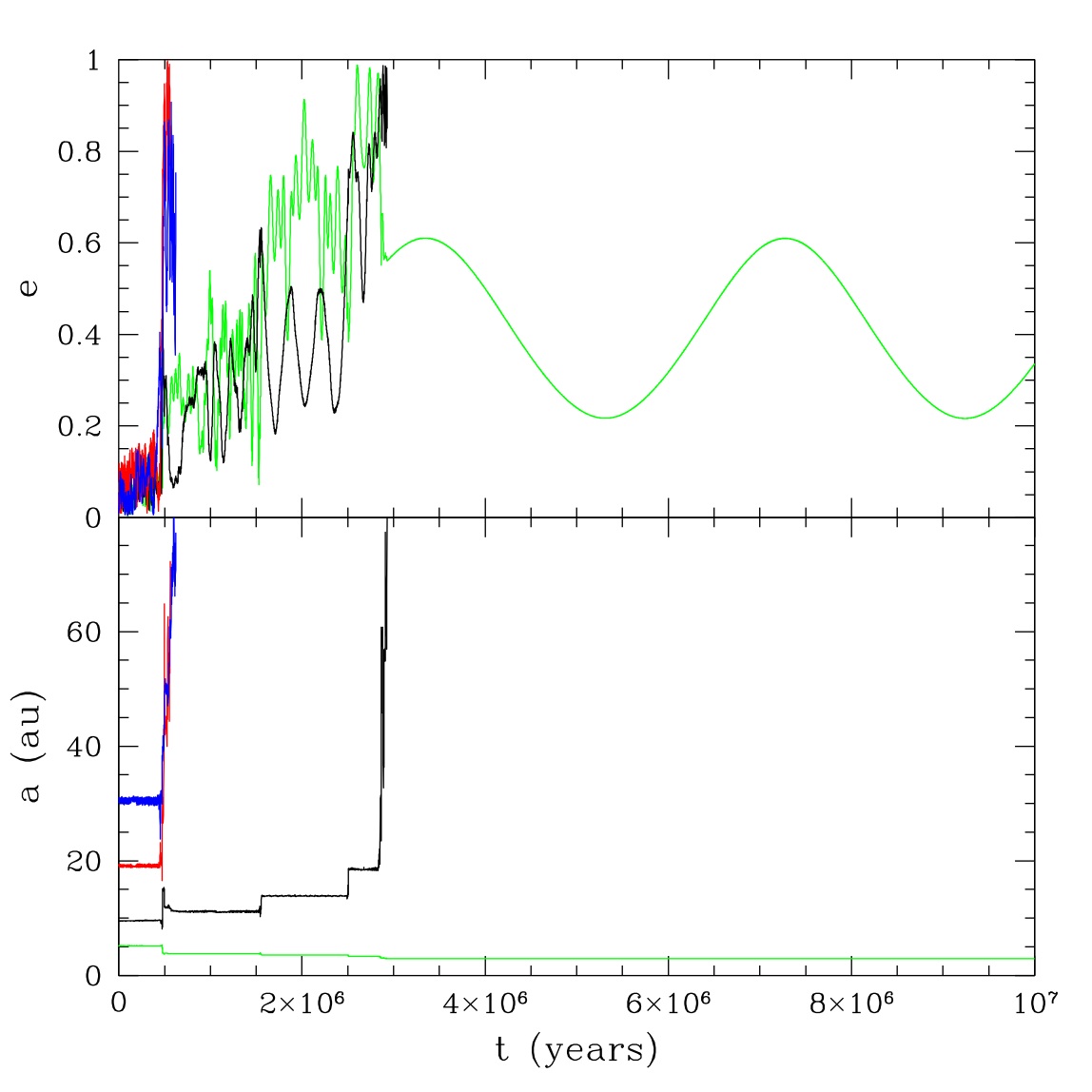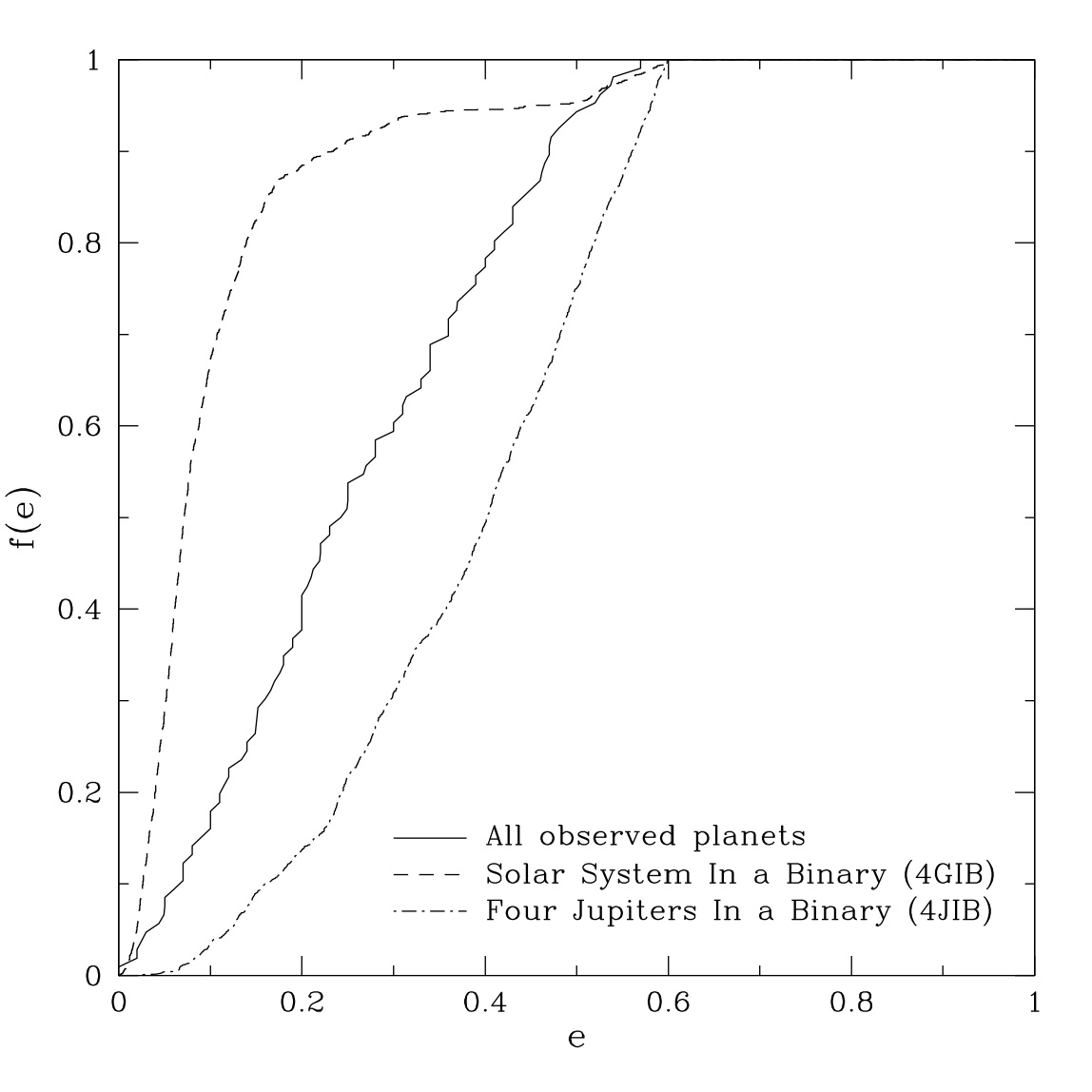The origin of eccentric exoplanets
Most observed extrasolar planets are gas giants with masses similar to, or greater than, those of the gas giants in the solar system. At the same time they are found on rather tight and eccentric orbits. Such orbits are very different from those of the gas giants in our solar system. Using numerical simulations of a large set of planetary systems we however show that at least some of the observed extrasolar planets might have formed in systems resembling the solar system.
Solar-system-like planetary systems (where the gas giants are on long-term stable orbits wider than about 5 au) can, as is evident from the solar system, form around initially single stars. If such a star is exchanged into a binary system in an exchange encounter in a young stellar cluster, the presence of the companion star may trigger strong planet-planet interactions. Whether this occurs or not most strongly depends on the inclination of the companion star with respect to the planets. For planet-hosting binaries formed in exchange encounters about 77 per cent of all systems will have an inclination greater than 39.2 degrees. When this is the case, the Kozai Mechanism operates, leading to high eccentricities among the planets, which in turn cause strong planet-planet interactions to occur. These may then lead to the ejection of one or more planets, leaving those remaining on tighter and more eccentric orbits.
What the final orbital elements are after the phase of strong planet-planet interactions and any subsequent ejections strongly depends on the mass distribution in the planetary system. If it is similar to the mass distribution in the solar system, which is very hierarchical, the change in the orbital elements will be rather small compared to the initial values. If the gas giants on the other hand all have rather similar masses (i.e. if they have a democratic mass distribution) the change is instead rather large.
Solar-system-like planetary systems in binaries will only contribute to the observed extrasolar planet population at intermediate distances from the host star (about 1-6 au). Within this semi-major axis range hierarchical systems produce an excess of planets with lower eccentricity than those observed, while democratic systems produce an excess of highly-eccentric planets. We find that a combination of the two can reproduce the observed eccentricities of extrasolar planets. You can read more about this study in the refereed article Malmberg & Davies (2008).

Figure 1
As an example of a democratic system we took the four giants in the Solar
System, and set the mass of each of them equal to that of Jupiter. We then
simulated the evolution of the system inside a binary with a semi-major axis of
300 au, where the companion star had a mass of 0.6 MSun and its
orbit an eccentricity of 0.3. Here we show an example of such a system, in
which the inclination between the companion star and the planets was set to 60
degrees. As can be seen there is an initial phase of strong planet-planet
interactions, followed by the ejection of three of the four planets. The
remaining planet is left on a much tighter (about 3 au) and rather eccentric
orbit.

Figure 2
The cumulative eccentricity distributions for a hierarchical system (the four
giants in the solar system) inside a binary (dashed line), a democratic system
(the four giants in the solar system, all with a mass equal to that of Jupiter)
inside a binary (dashed-dotted line) and the observed extrasolar planets (solid
line). Note that we here only include planets with semi-major axis between 1
and 6 au and with eccentricity less than 0.6. To generate the eccentricity
distributions we ran 200 simulations of each system inside a binary with a
semi-major axis of 300 au, an eccentricity of 0.3 and a companion star mass of
0.6 times that of the sun. Between the runs we drew the inclination of the
companion star from an isotropic distribution between 0 and 90 degrees and
randomly selected the initial positions of the planets in their respective
orbits. As can be seen the democratic systems produce too many
high-eccentricity planets, while the hierarchical systems produce too many
low-eccentricity planets. Only a combination of the two can provide a
reasonable match to the observed planets.